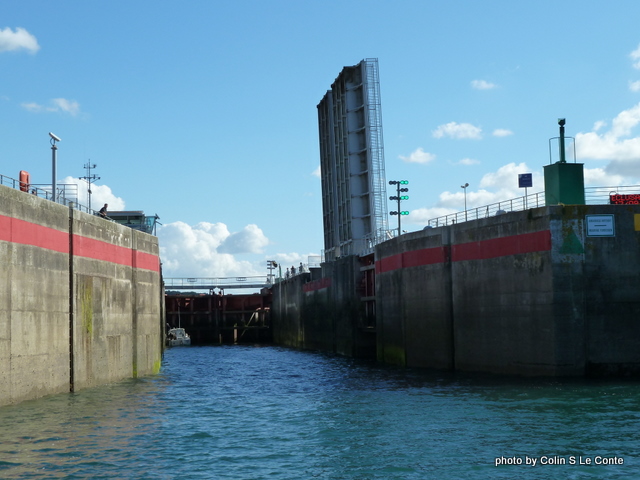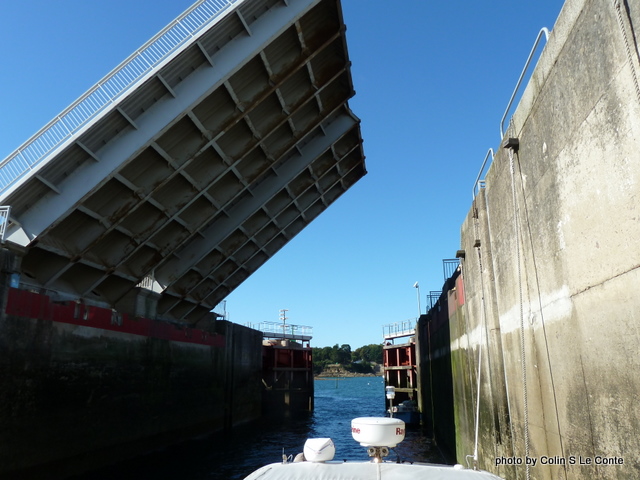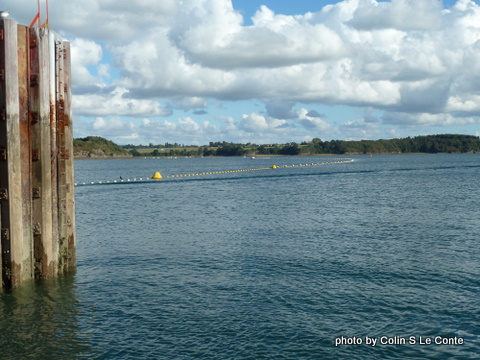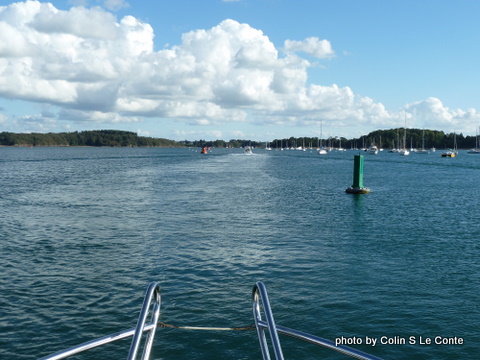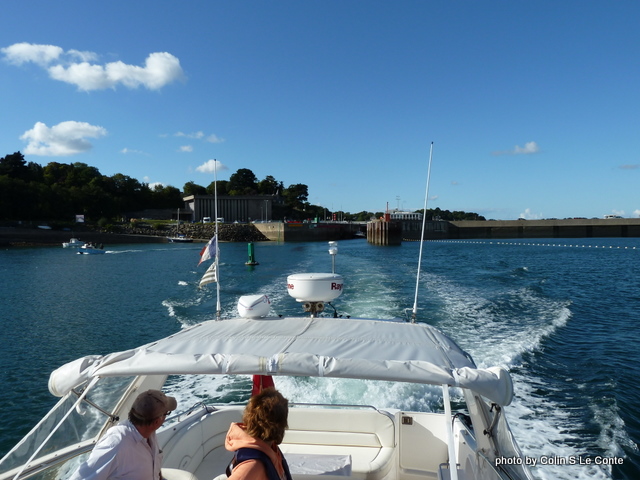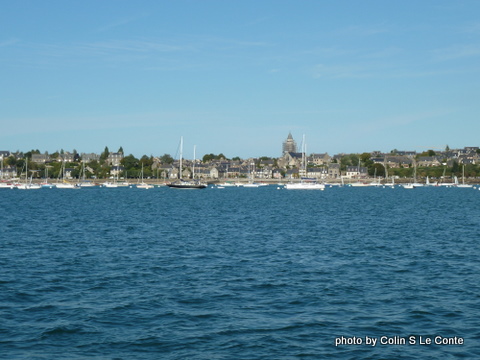![]()
The Rance is a complete holiday in itself. Approaching the Rance Barrage from Saint-Malo, the route is well marked and it is only a couple of miles. Past the picturesque St Servan with its Solidor Tower and approach the barrage.
Barrage time tables
The link below gives you a 3 week looking forward programme by day by using the green Export data tab which is a printable PDF. If you use Google translate the French SAS comes out translated as Airlock but what it means is lock operation.
If you use the Blue tab to select a date you can go forward to specific dates in the year, day by day.
www.edf.fr/usine-maremotrice-rance/maree…
The tab at the bottom Comment Passer L’Ecluse du Barrage du Rance gives you an info sheet but only in French with a telephone number so you can phone them up with a query.
YouTube videos
Sped up – Leaving the Vauban marina and heading through the Rance barrage and then a little way up the river youtu.be/XAxifYkv0LM
Entering the Rance Barrage lock gate from the sea with road raised – youtu.be/X_cKVSjrq3M
Entering the Rance Barrage lock gate from the Rance – youtu.be/UEmU6fJZxY4
Leaving the Rance Barrage lock and heading out to sea, then entering the Sablons marina – youtu.be/5VtpjdZebpw
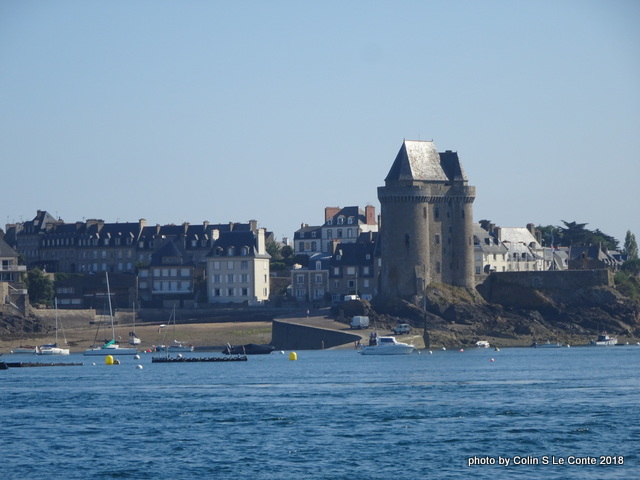
The Solidor Tower outside of Saint Servan
There are some white holding buoys on the left, but they are quite difficult to attach a line unto.
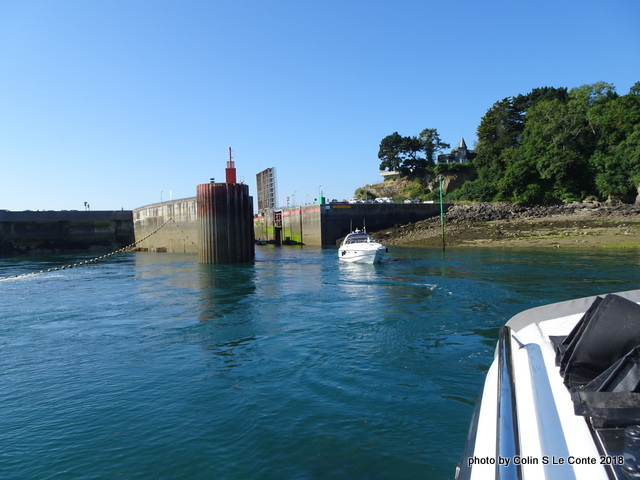
This is the lock entrance from the sea
The lights on the barrage are quite clear and there is also a red message board. Take some binoculars as it makes it easier to read. You can also call them on VHF Channel 13 or call 33 299 462187. They normally only speak French.
Note – when the lights are green but with a white light in the middle, then you may proceed ONLY when you have specific orders. Normally it means there is a ferry or other vessel which has priority.
On the hour, the barrage opens. This is only if the sea is at 4m or higher. So on neap tides it opens every hour and on spring tides, you need to check to see when it will be operating. In the summer (July and August), the locks do not operate at key times in view of the disruption it causes to road traffic. In 2018 this was 12:00, 14:00, 17:00 and 19:00. Yachts go in first so they can close the bridge ASAP and then motor boats.
The tide in the Rance is not the same as the sea. The Barrage holds the water around high water and low water and then lets it flood in or out for 4 hours. So there is a lag in the tides and it can move very quickly. The lag tends to be around 2 hours but does vary depending on the times for demand for electric.
See tide.frbateaux.net/52 for sea tide information.
On the way back down the Rance, we found the barrage opens as soon as they are ready to let the boats from the sea out. On one lock this was only 10mins after the hour. They close the lock about 45mins after the hour and do not close the road and open the bridge until exactly on the hour in order to minimise inconvenience to drivers.
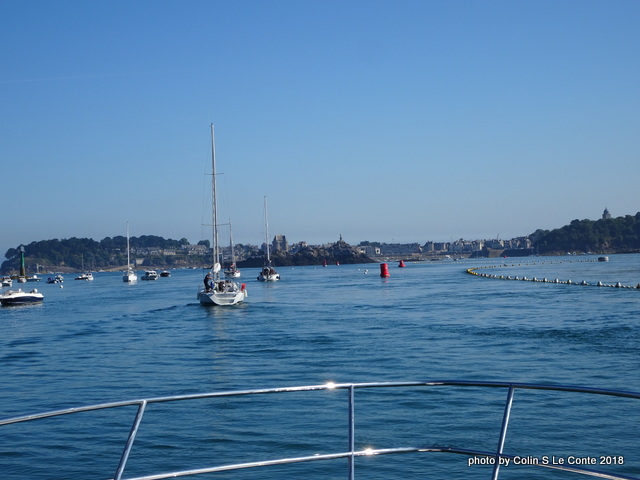
As you come out of the lock on the sea side – there may be a lot of tide
Special Information 2018
There are large tubes across the Rance a few hundred metres up the river from the barrage. We were told they are laying a cable across the river and the tubes are there to assist. We were also told you can pass between any of them. Anyway, they have marked one red and one green to avoid confusion or undue alarm and it is probably best to pass between those two tubes. I took a picture for the website. Let me know when they have gone and I will remove this warning.
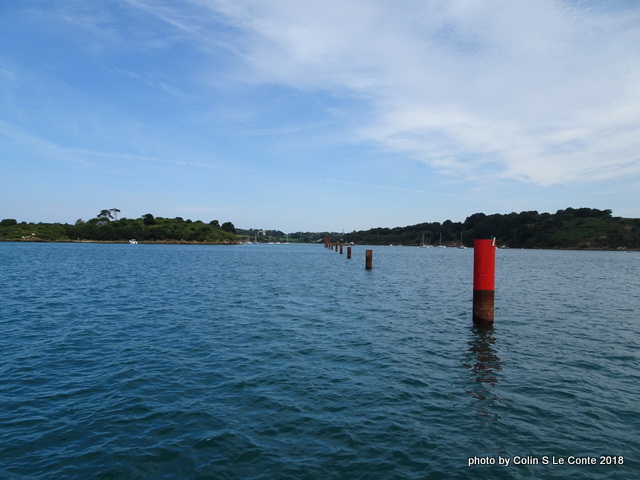
Passing through the tubes
Pilot Guide
Phone number for a recorded message in English of the Barrage Lock times and the time and Height of water in the Rance
02 99 16 37 33.
Information on water levels: 02 99 16 37 33
Press 2 for English
Then press either
- 1 for Water levels
- 2 for Lock Times
- 3 for Bridge Times
The information you need to navigate the Rance
From my research, you need to documents. If anyone knows any further information that would help fellow boaters, do let me know
- Information on lock times
The colours are
- Red – impossible due to the tide
- Green – Free opening
- Blue – possible at 1/2 hours with an air draft (height) of 4m or less.
- Orange – impossible due to prefectural decree
- Orange with an X – impossible due to prefectural decree but possible without raising the bridge with an air draft (height) of 4m or less.
- Green with an I – Free opening but there may be a limitation (I think it is related to the draft of the boat)
We went through on Blue when the tide had dropped a fair bit and they said there was 4m 10cm clearance. We are just over 4m and cleared by a few inches. It was really tight. So when they say 4m, they do mean 4m. Also – make sure you know the height of your boat above sea level accurate to a couple of cm.
2. The tide times are published every Friday for the following week. We spoke to the Vauban marina office and they had no information. The only information we can find online is this Plouer site. We are told Liliane types them in! www.plouer-sur-rance.fr/niveaux-en-rance…
This tells you the high tide times for the next week, the times of the Chatelier lock and the opening times for Plouer marina.
Terms
Tirant d’air is your air draft (height) and tirant d’eau is your water draft.
This site is useful rancecotedemeraude.fr/
VHF channel 13
www.noonsite.com/Countries/France/StMalo
Mooring areas
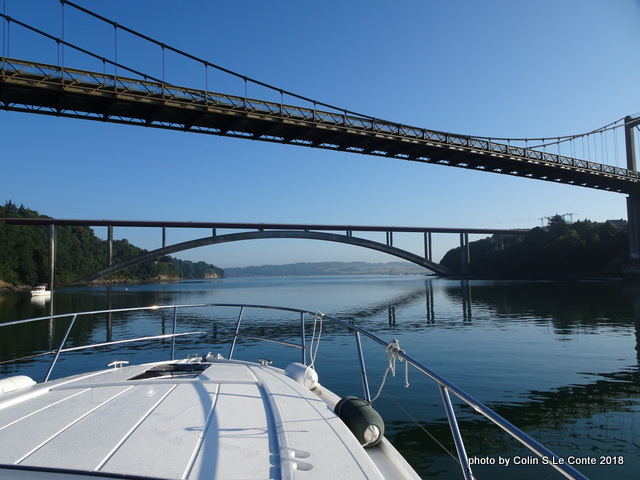
Heading up the Rance can be beautiful
St Suliac
You will have to pay for the anchorage and the harbour master will visit your boat early in the morning with his dingy to ensure he gets your pennies.
Plouer
There is only one marina before the Chatelier lock called Plouer sur Rance. See www.digimap.gg/marine/marinas/river-ranc…
Chatelier Lock
Required 8.5m of water. This is Rance water tide levels, not the sea levels and is based on the filling and pulling out the plug on the Rance. This lock is opened and closed on demand and only operates during certain hours. It is quite a slow lock so leave plenty of time. See www.digimap.gg/marine/marinas/river-ranc…
Lyvet
Immediately the other side of the Chatelier lock on the canal side is Lyvet marina. See www.digimap.gg/marine/marinas/river-ranc…
Dinan
Once through the Chatelier lock – you have all the time in the World as it is no longer tidal or affected by the pulling out of the plug at the barrage. See www.digimap.gg/marine/marinas/river-ranc…
The journey times
The speed limit on the Rance is said to be 10 knots. We went on a ferry which stuck to 10 knots although a lot of boats do go a lot faster. There are no signs indicating a speed limit. Above Plouer, it is best to go slower in order not to cause too much disturbance of the banks and wildlife.
We checcked with the Harboumaster at Plouer and she said the speed limits are as follows:
5 knots when within 300m of land. Otherwise you should go the best speed to minimise your wash. Below St Suliac you can do any speed. So above Plouer on the way to Lyvet / Dinan. Most of the passage should be at 5 knots.
Barrage to Plouer – approx 1 hour
Barrage to the Chatelier lock is over an hour. Probably allow 1 hour 30 mins
Another reader of this website wrote me this great article
“Rather than going to the St Malo marinas, better though to go thru the Barrage as soon as poss and head up to Plouer or even drop anchor at St Suliac – there are lots of visitor buoys and there is a lovely restaurant on the small harbour there. It also does not dry out here. Then when the tide permits go on up to Le Chatelier and Dinan. Allow yourself a minimum of 2 hours before HW to make sure you have enough water.
The Rance barrage can be ‘fun’. Check the time of opening in the tide tables and get to the waiting area about half an hour before. If the tide is falling the speed at which the water is let out of the Rance thru the Barrage is amazing – around 8 to 10 knots. There are some holding buoys available but these are incredibly difficult to pick up as there are no ropes attached and in the tide is v scary. Better to drop anchor in the small bay alongside the lock which is out of the tide run or in the bay a mile or so away.
Be careful if you telephone them to find out the lock opening times. We tried this in June 2010 and got an English tape giving the times. However, it was not accurate which meant we got there 2 hours too early. They can and do change the opening times to suit conditions. The most accurate way to find out is when you get to the barrage there is a digital readout giving all of that days times.
They load the inward lock with sailing boats first as they have to lift the road bridge because of masts heights then smaller motor boats last as they can get under the bridge. They like to open the bridge for as short a time as possible. The lock is quite small and it can be a bit of a squeeze especially when its full of boats all bumping into each other – try to keep well away from them!!. It is also filthy dirty and there are not many hanging mooring ropes to hang onto under the bridge. What we do now in locks is to moor up the stern only and not bother with the bow. I keep the boat straight by giving the bow thruster a blip every now and then to keep the bow in. The barrage lock tends to push the stern outwards into the lock.
To get thru takes about 15/20 mins. Coming back out is the same in reverse but is a bit easier to wait for the lock to open with better and easier waiting areas. Once through make sure you have plenty of water and only go up on a rising tide. It is incredible how fast the water empties from the river – you can actually watch it drop! If you’re going up to Le Chatelier again at or just before high water is ideal. Once past Plouer the river can get very narrow. It is absolutely essential to follow the buoyed passage. Some of them look totally wrong but they aren’t! There is only a very narrow channel. When you look at the river from Le Chatelier lock wall at low water you will see how narrow it is.
Le Chatelier lock times are also in the tide tables. But they will open on demand especially when they are quiet. I have tried to radio in the past but never get a reply. There is a small holding pool just in front of the lock but no buoys. I normally give a toot so they know I’m there because you’re never sure if the lock keeper is in her office or not.
The most important thing about the Rance is to make sure you have plenty of water – the times we have been we have always hit the bottom at some point!! Fortunately, all mud so no damage but your outdrives will never be as clean again!”
Interesting site on places to see on the Rance valderance.free.fr/
www.gitesandmore.co.uk/River%20Rance.htm
Interesting blog – especially for sailing boats sarahjaneodyssey.blogspot.com/2010/06/up…
The RYA have advised us that the inland waterways and therefore the requirement for CEVNI is deemed to be as follows:
the inland waterway limits for French Maritime registration. For the Canal de Caen à la mer the limit is ” Pont de l’écluse de l’Orne” and for the Rance, the limit is “Vieux Pont de Dinan”.
Buses – see www.breizhgo.com/en/
Restaurant – www.tripadvisor.com/Restaurants-g187098-…
2018 – further up river above Dinan – up at Evran they were working along the quay putting in new water points and electric points so that people will not have to run cables to the toilet block in future

